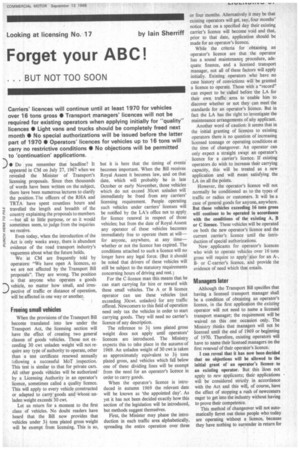Looking at licensing No. 17
Page 99

If you've noticed an error in this article please click here to report it so we can fix it.
Forget your ABC!
. . BUT NOT TOO SOON
by lain Sherriff Carriers' licences will continue until at least 1970 for vehicles over 16 tons gross • Transport managers' licences will not be required for existing operators when applying initially for "quality" licences • Light vans and trucks should be completely freed next month • No special authorizations will be issued before the latter part of 1970 • Operators' licences for vehicles up to 16 tons will carry no restrictive conditions • No objections will be permitted to 'continuation' applications. ) • Do you remember that headline? It appeared in CM on July 27, 196'7 when we revealed the Minister of Transport's licensing proposals. Since then thousands of words have been written on the subject, there have been numerous lectures to clarify the position. The officers of the RHA and TRTA have spent countless hours and travelled the length and breadth of the country explaining the proposals to members —but all to little purpose, or so it would sometimes seem, to judge from the inquiries we receive.
Even today, when the introduction of the Act is only weeks away, there is abundant evidence of the road transport industry's vagueness about what the future holds.
We at CM are frequently told by operators: "We have open A licences, so we are not affected by the Transport Bill proposals". They are wrong. The position is that anyone who operates a goods vehicle, no matter how small, and irres pective of traffic or distance of operation, will be affected in one way or another.
Freeing small vehicles When the provisions of the Transport Bill become translated into law under the Transport Act, the licensing section will have the effect of creating two general classes of goods vehicles. Those not exceeding 30 cwt unladen weight will not require any type of authority to operate, other than a test certificate renewed annually following a successful MoT inspection. This test is similar to that for private cars. All other goods vehicles will be authorized ' by a Licensing Authority in an operator's licence, sometimes called a quality licence. This will apply to every vehicle constructed or adapted to carry goods and whose unladen weight exceeds 30 cwt.
Let us return for a moment to the first class of vehicles. No doubt readers have heard that the Bill now provides that vehicles under 3+ tons plated gross weight will be exempt from licensing. This is so, but it is here that the timing of events' becomes important. When the Bill receives Royal Assent it becomes law, and on that date, which will probably be in late October or early November, those vehicles which do not exceed 30cwt unladen will immediately be freed from any carriers' licensing requirement. People operating such vehicles under carriers' licenses will be notified by the LA's office not to apply for licence renewal in respect of those vehicles; but from the date of Royal Assent any operator of these vehicles becomes immediately free to operate them at will— for anyone, anywhere, at any time— whether or not the licence has expired. The conditions attached to such a licence will no longer have any legal force. (But it should be noted that drivers of these vehicles will still be subject to the statutory requirements concerning hours of driving and rest.) For the C-licence man this means that he can start carrying for hire or reward with these small vehicles. The A or B licence operator can use these vehicles (not exceeding 30cwt. unladen) for any traffic offered. Newcomers to this field of operation need only tax the vehicles in order to start carrying goods. They will need no carrier's licence of any description.
The reference to 3+ tons plated gross weight does not apply until operators' licences arc introduced. The Ministry expects this to take place in the autumn of 1969. An unladen weight of 30 cwt is taken as approximately equivalent to 3+ tons plated gross, and vehicles which fall below one of these dividing lines will be exempt from the need for an operator's licence in order to carry goods.
When the operator's licence is introduced in autumn 1969 the relevant date will be known as 'the appointed day'. As yet it has not been decided exactly how this section of the legislation will be introduced, but methods suggest themselves.
First, the Minister may phase the introduction in each traffic area alphabetically, spreading the entire operation over three




































































































































































































































































